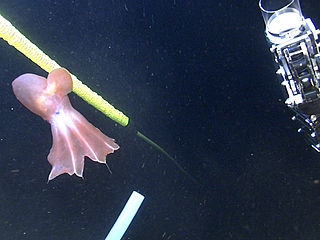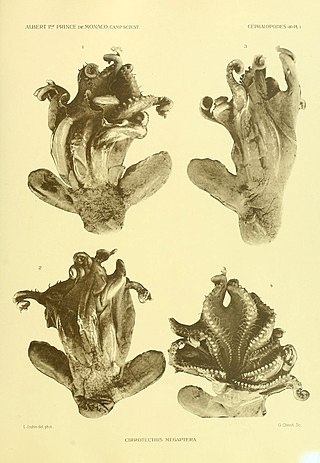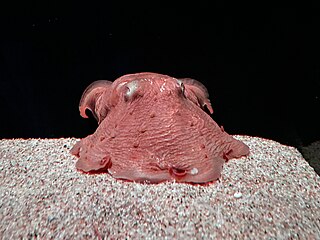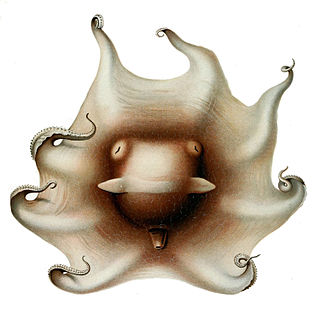
An octopus is a soft-bodied, eight-limbed mollusc of the order Octopoda. The order consists of some 300 species and is grouped within the class Cephalopoda with squids, cuttlefish, and nautiloids. Like other cephalopods, an octopus is bilaterally symmetric with two eyes and a beaked mouth at the centre point of the eight limbs. The soft body can radically alter its shape, enabling octopuses to squeeze through small gaps. They trail their eight appendages behind them as they swim. The siphon is used both for respiration and for locomotion, by expelling a jet of water. Octopuses have a complex nervous system and excellent sight, and are among the most intelligent and behaviourally diverse of all invertebrates.

The Mastigoteuthidae, also known as whip-lash squid, are a family of small deep-sea squid. Approximately 20 known species in six genera are represented, with members found in both the mesopelagic and bathypelagic zone of most oceans. Originally described by Verill in 1881, it was later lowered by Chun (1920) to a subfamily (Mastigoteuthinae) of the Chiroteuthidae. However, Roper et al. (1969) raised it back to the family level, and this has not been changed since. The taxonomy of this family is extremely unstable, and there have been at times one genus, two genera and four subgenera(Salcedo-Vargas & Okutani, 1994), two genera and several 'groups', five genera and one species with an uncertain placement, or six genera.

Oegopsida is one of the two orders of squid in the superorder Decapodiformes, in the class Cephalopoda. Together with the Myopsina, it was formerly considered to be a suborder of the order Teuthida, in which case it was known as Oegopsina. This reclassification is due to Oegopsina and Myopsina not being demonstrated to form a clade.

Idioteuthis cordiformis is a species of whip-lash squid found in tropical regions of the west Pacific Ocean. The species is commonly known as the 'love-heart squid' because the species name cordiformis is Latin for 'heart shaped'. Recently, this species has been found to consume small birdbeak dogfish.

Idioteuthis is a genus of whip-lash squid containing at least one species. Some teuthologists consider it synonymous with Mastigoteuthis, but genetics have confirmed the placement of this genus as distinct from all other genera in this family. The placement of Idioteuthis within the Mastigoteuthidae remains uncertain.

Mastigoteuthis agassizii is a species of whip-lash squid. It is the type species of the genus.

Echinoteuthis atlantica is a species of whip-lash squid from the family Mastigoteuthidae. It occurs in the eastern North and South Atlantic Ocean. This squid is red in colour and similar to Echinoteuthis famelica of the Pacific but differs in having a well developed protective membrane on the tentacular club which is absent on E. famelica. The presence on this membrane on Echinoteuthis glaukopis from the Indian Ocean suggests that this may be a synonym of E. atlantica, in which case glaukopis has priority.

All cephalopods possess flexible limbs extending from their heads and surrounding their beaks. These appendages, which function as muscular hydrostats, have been variously termed arms, legs or tentacles.
Sepia zanzibarica, or the Zanzibar cuttlefish, is a species of cuttlefish native to the Indian Ocean.

Cirroteuthis muelleri, also known as the big-finned jellyhead, was the first cirrate octopus species to be scientifically described. It is closely related to the genus Cirrothauma within the family Cirroteuthidae. At present the genus contains a single recognized species restricted to the Arctic Ocean and northern basins of the Atlantic and Pacific, but other species may be present in the southern hemisphere.

A sucker in zoology is a specialised attachment organ of an animal. It acts as an adhesion device in parasitic worms, several flatworms, cephalopods, certain fishes, amphibians, and bats. It is a muscular structure for suction on a host or substrate. In parasitic annelids, flatworms and roundworms, suckers are the organs of attachment to the host tissues. In tapeworms and flukes, they are a parasitic adaptation for attachment on the internal tissues of the host, such as intestines and blood vessels. In roundworms and flatworms they serve as attachment between individuals particularly during mating. In annelids, a sucker can be both a functional mouth and a locomotory organ. The structure and number of suckers are often used as basic taxonomic diagnosis between different species, since they are unique in each species. In tapeworms there are two distinct classes of suckers, namely "bothridia" for true suckers, and "bothria" for false suckers. In digeneal flukes there are usually an oral sucker at the mouth and a ventral sucker posterior to the mouth. Roundworms have their sucker just in front of the anus; hence it is often called a pre-anal sucker.
Loliolus is a genus of squid from the family Loliginidae from the Indo-Pacific region. The genus is divided into two subgenera Loliolus and Nipponololigo. They are small squids of less than 150 mm (5.9 in) in mantle length which have an expanded tentacular club. This club has 4 series of suckers. The sucker rings have plate-like teeth which are square in shape all around them. The males' hectocotylus has a ventral crest which is created by the fusion of the protective membrane with the ventral series of papillae and this crest completely obscures the conical shape of the papillae. The mantle is rounded posteriorly and lacks the posterior tail-like lobe while the fins are positioned on the rear of the mantle and extend to the posterior tip of the mantle. Their eggs are small and the males' spermatophore has a short cement body. They do not possess photophores. The two subgenera are distinguished by the hectocotylus which in Loliolus encompasses the entire arm and there are no unmodified suckers while in Nipponololigo the arm is only partly hectocotylsed and has normal suckers at its base.
Eucleoteuthis is a monotypic genus of squid from the family Ommastrephidae; the only species is Eucleoteuthis luminosa, the striped flying squid or luminous flying squid.
Ornithoteuthis volatilis, the shiny bird squid, is a squid from the subfamily Ommastrephinae, the flying squids, of the family Ommastrephidae part of the pelagic squid order Oegopsida. It is a tropical and sub-tropical species which is widely distributed in the Indo-Pacific oceans. It is slightly larger than the closely related species Ornithoteuthis antillarum of the Atlantic Ocean.

Grimpoteuthis megaptera is a species of octopus known from five specimens, collected by Addison Emery Verrill. Between two and three of these specimens may belong to different species.
Opisthoteuthis albatrossi is a cirrate octopus originally found off Kinkasan in Japan. This species was described from only four specimens. It is similar to Opisthoteuthis californiana; the two may be the same species. It is also similar to Opisthoteuthis japonica.

Opisthoteuthis depressa, also known as the Japanese flapjack octopus, is an octopus found in waters near Japan.

Opisthoteuthis extensa is a species of octopus found off the west coast of Sumatra, an Indonesian island. It lives at a recorded depth of 768 m (2,520 ft). O. extensa lives in a benthic habitat, like many other cirrate octopuses. It occupies a deep part of the ocean where little sunlight penetrates.

Opisthoteuthis grimaldii is an octopus found near the Azores.

Octopus conispadiceus is a species of long-ligula octopus, provisionally placed in the genus Octopus. It was first described by Madoka Sasaki in 1917 based on specimens bought at a fish market in Sapporo, Japan.















